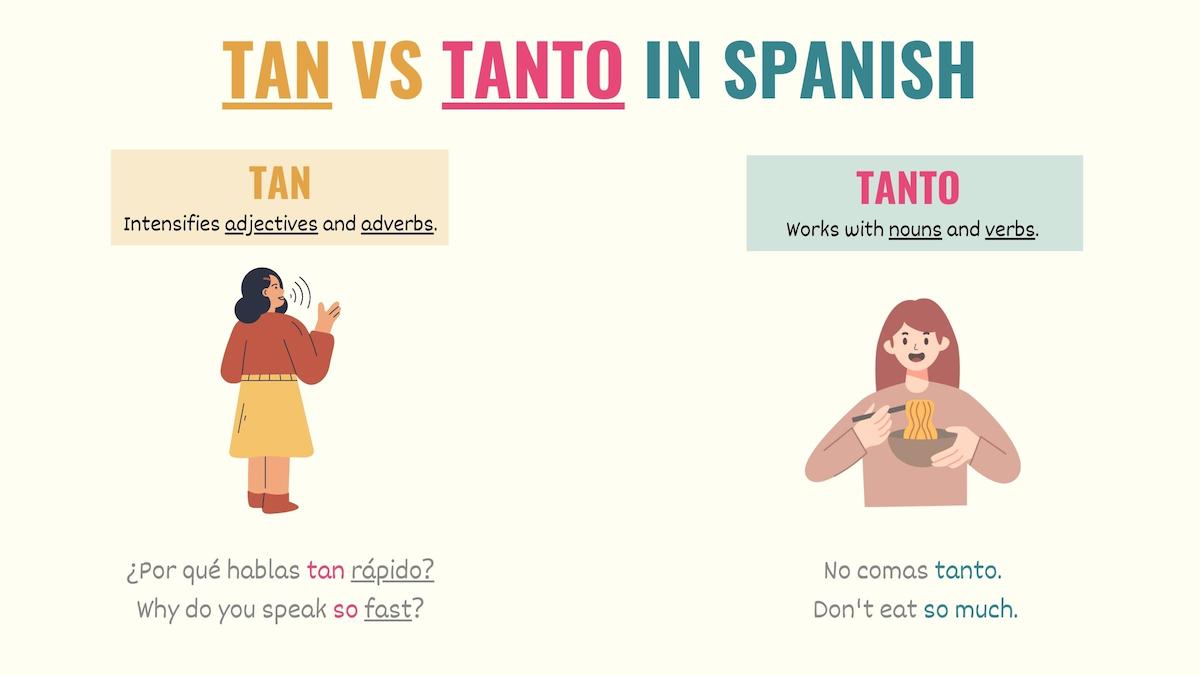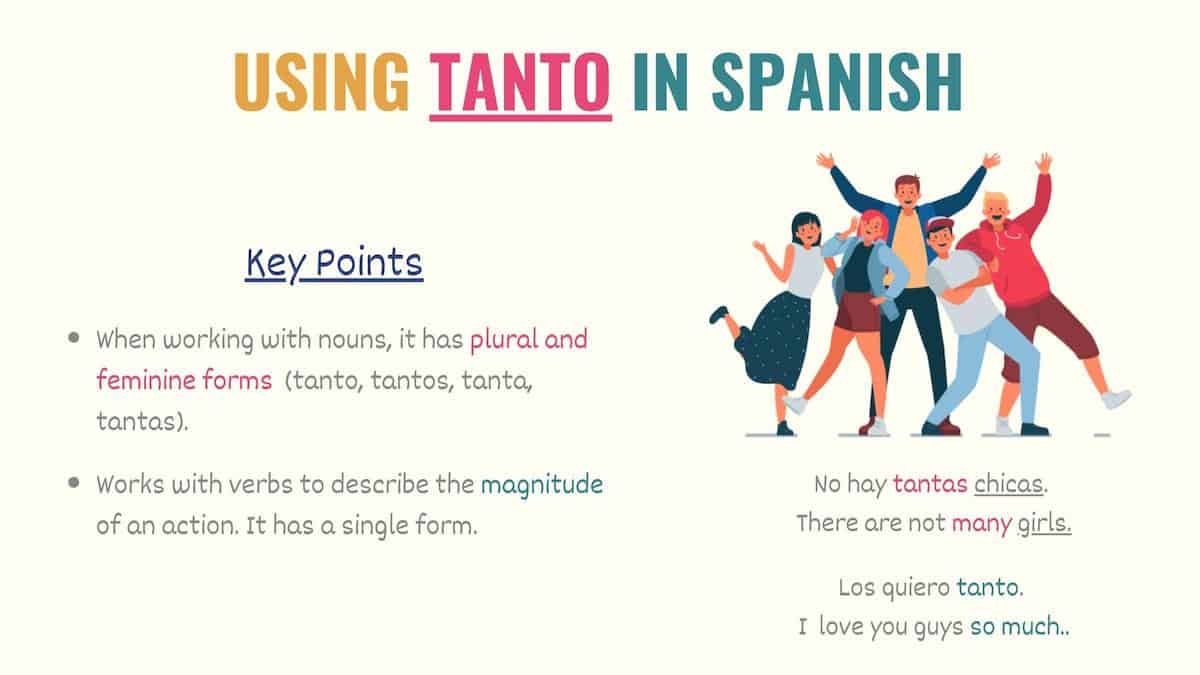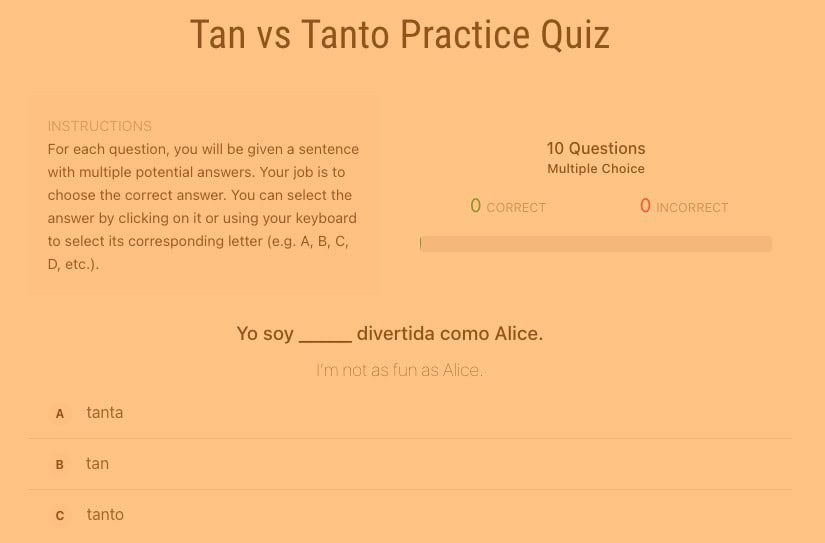When learning Spanish, tan vs tanto can be a confusing set of words. They look alike and share some of the same uses, such as making comparisons (tan como or tanto como). But despite their similarities, there are significant differences between these words.
Tan and tanto are basic words we use on a daily basis. So, in this guide, you’ll learn how and when to use them. Here is a quick overview of what we’ll cover:
- Tan vs Tanto: What’s the Difference
- How & When to Use Tan in Spanish
- How & When to Use Tanto in Spanish
- Key Points
- Practice Quiz
- Downloadable PDF
Tan vs Tanto: Difference Between Tan and Tanto
In Spanish, tan is always placed in front of an adjective or an adverb and it intensifies the characteristics provided by these words. Tanto works with nouns or verbs to talk about amounts or the magnitude of an action. When working with nouns, tanto has singular and plural forms.

Tan vs tanto relates to quantity and magnitude. So, the difference between them comes down to one thing: the type of words they can work with. Let’s break this down, shall we?
Tan is an adverb of manner in Spanish. This means that it can only work with another adverb or an adjective. Its job is to intensify the magnitude of the qualities described by these words.
¿Por qué está tan caro?
Why is it so expensive?
Ella es tan rápida como tú.
She is as quick as you.
On the other hand, tanto works with nouns and verbs. When qualifying nouns, tanto is an adjective of quantity, meaning that it tells you the amount of something. In this context, tanto must mark the gender and number of the word:
No tengo tanto dinero.
I don’t have that much money.
¿Por qué tienes tantas camisas?
Why do you have so many shirts?
When working with verbs, tanto has a single form and conveys the magnitude or intensity of an action. For example:
Carlos habla tanto como tú.
Carlos speaks as much as you.
You’ll learn when to use tan and tanto in the following sections.
How & When to Use Tan in Spanish
In Spanish, tan only works with adjectives or adverbs. In fact, it must always be placed in front of these words and doesn’t have a plural form. Depending on how it’s used, tan means:
- So
- Such
- As…as
- How
These are the situations when you’ll use tan in Spanish:
Tan…como – making comparisons
One of the most common ways to use tan is to make comparisons of equality in Spanish. Simply put, we use the structure tan…como to compare qualities or how people do certain things.
[Person 1] + tan + [adjective/adverb] + como + [person 2]
Betty es tan alta como tú.
Betty is as tall as you.
Jonathan cocina tan bien como su mamá.
Jonathan cooks as good as his mom.
This formula and pattern for making comparisons of equality can also be applied to other types of nouns (or objects) being compared.
El coche rojo es tan grande como el coche azul.
The red car is as big as the blue car.
Intensify qualities
Use tan combined with another adverb or a qualifying adjective to intensify the magnitude of a certain characteristic:
[Verb conjugated] + tan + [adjective/adverb]
¿Por qué comes tan lento?
Why are you eating so slowly?
Lucy vive en una casa tan bonita.
Lucy lives in such a beautiful house.
Ask about characteristics
Tan is also used with the question word ‘qué’ to inquire about the degree of a characteristic or an action. For example:
¿Qué tan + [adjective/adverb] + [verb] + [noun]
¿Qué tan confiable es este carro?
How reliable is this car?
¿Qué tan rápido puedes venir?
How fast can you come?
When & How to Use Tanto in Spanish

As established before, tanto only works with verbs or nouns. Based on how it’s used, ‘tanto’ means:
- So many / So much
- As many…as / As much…as
Below are some of the most common situations when you’ll use tanto in Spanish.
Express the quantity of something
In Spanish, we use tanto to refer to large amounts of something. Since, in this context, this word is an adjective that qualifies nouns, you must use the correct form of tanto:
- Tanto for singular masculine nouns.
- Tantos for plural masculine nouns.
- Tanta for feminine singular nouns.
- Tantas for plural feminine nouns.
[Verb conjugated] + [tanto(s)/tanta(s)] + [noun]
Tengo tanto trabajo por hacer.
I have so much work to do.
¿Por qué necesitamos tantas firmas?
Why do we need so many signatures?
Express the magnitude or intensity of an action
We can use tanto with verbs to express the intensity or magnitude of an action. In this case, ‘tanto’ is working as an adverb, meaning that it won’t have a plural or feminine form.
[Verb conjugated] + tanto
Te quiero tanto.
I love you so much.
Nunca había comido tanto.
I have never eaten so much.
Tanto…como – comparing quantities or magnitudes
In Spanish, we use the structure tanto como to compare the amounts of something or the intensity of an action. When making these comparisons, you must follow the rules of tanto.
In other words, mark the gender and number when qualifying nouns, or use a single form when working with verbs. Here are some examples:
[Person 1] + [verb conjugated] + [tanto] + (noun) + como + [person 2]
Tengo tantos amigos como tú.
I have as many friends as you.
Mis primos comen tanto como ustedes.
My cousins eat as much as you.
Make numerical approximations
In conversational Spanish, tantos is used to express numerical approximations when we don’t know or want to share exact amounts.
Joana tiene treinta y tantos años.
Joana is in her thirties.
Creo que nos costó dos mil y tantos.
I think it costs us around two thousand.
Key Points
When you don’t understand their differences, tan vs tanto can seem confusing and complicated. So, in this article, we’ve gone through the meanings and applications of these words. Here are some key points you want to remember:
- Both tan and tanto express quantity or magnitude.
- Tan is an adverb and only works with other adjectives or adverbs. It intensifies characteristics and has a single form.
- Depending on the sentence, tanto can be an adjective or adverb.
- As a Spanish adverb, tanto works with verbs to express the intensity or magnitude of an action. It has a single form.
- When working with nouns, tanto is an adjective and refers to big amounts of something.
- As an adjective, tanto has singular and plural forms to mark the gender and number of the noun.
- Both tan and tanto work with comparative structures. However, tan como is only used to compare qualities, whereas tanto como compares amounts or actions.
Practice Quiz

Now that you’ve learned the difference between these words, you should take this tan vs tanto practice quiz.
Download the Tan vs Tanto in Spanish PDF
It can be tricky to remember all the rules and points on the difference between tan and tanto. I’ve created a short PDF cheat sheet with the key points on the differences, graphics, and notes on how and when to use tan and tanto in Spanish.



